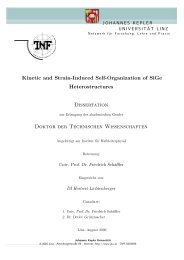Diplomarbeit Diplom-Ingenieur - Institut für Halbleiter
Diplomarbeit Diplom-Ingenieur - Institut für Halbleiter
Diplomarbeit Diplom-Ingenieur - Institut für Halbleiter
You also want an ePaper? Increase the reach of your titles
YUMPU automatically turns print PDFs into web optimized ePapers that Google loves.
40<br />
of this line is due to a slight tilt away from the zone axis to increase the contrast of the<br />
dark field image. The classification of the dots with respect to their size shows a<br />
narrow distribution with a maximum at about 8nm. The upper limit is again sharper<br />
than the lower one, and appears at 11 nm. The smallest dot was 3.5 nm large, but it<br />
was strongly blurred and could also be 5 nm large. The accuracy of this measurement<br />
was about 0.2 nm if the interfaces are sharp for larger dots and get worse for smaller<br />
dots, which can be explained by the shrinking (110) interface down to almost zero, as<br />
can be seen in the cross sectional image of figure 4.8.<br />
The comparison of these two specimens showed that the size of the dots depends<br />
strongly on the original layer thickness. Unfortunately, the cross-sectional specimen<br />
of a 3nm layer was not good enough for statistical evaluation and comparison with the<br />
5nm sample. A rough estimate of the mean volume of the dots from the 3nm layer<br />
resulted in about 6000nm 3 . An accurate estimate of the mean dot volume of the 1nm<br />
samples is 335nm 3 , which corresponds to a dot density of 3 10 11 cm -2 . The largest one<br />
is that from the 5nm layer with a mean volume of about 8000nm 3 , which corresponds<br />
to a dot density of about 6 10 10 cm -2 . Thinner layers break up in dots with smaller<br />
volume. On the other hand, the larger dots of e.g. a 5nm layer, collect much more<br />
material. The volume of the large dots of the 5nm layer is ~25 time larger than for that<br />
ones of the 1nm layer, but the thicker 5nm layer has only 5 times more material per<br />
unit area than a 1nm layer. Thus, one can find 5 times more small dots precipitating<br />
from a 1nm layer than large ones from a 5nm layer.<br />
4.4 Equilibrium shape<br />
As shown in part 4.3, the shape appearance of the dots changes with their size. The<br />
{111} interfaces do not seem to shrink with the same ratio as the others do, when dots<br />
get smaller. As the {111} facets are the interfaces which are hardest to resolve in high<br />
resolution images. The aim of this chapter is to describe the expected shape of the<br />
dots with attention on the {111} interface.<br />
Figure 4.10 shows the length L of the projected (111) interface of dots with<br />
different height H. Only dots with highly symmetric shape of sample series #11 and<br />
#28 were used, which have almost the same height and width. The cross sectional<br />
images of these samples were evaluated. The measurements show that the length of<br />
the {111} interface is almost independent of the size of the dot and varies in a range<br />
of 7 to 10 nm. An exception of this can be found if the interface falls together with a











